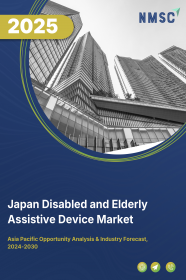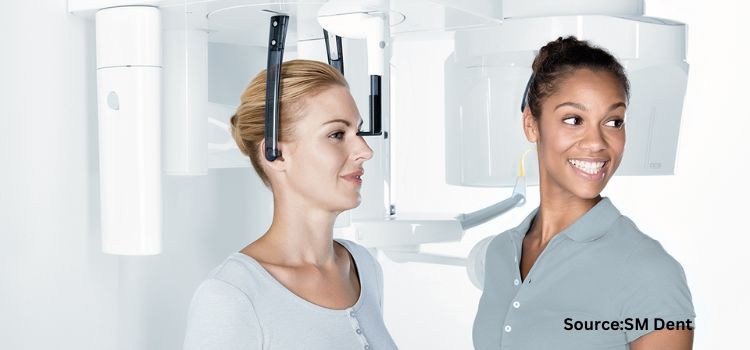
Japan Disabled and Elderly Assistive Device Market by Type (Mobility Impairments, Hearing Impairments, Visual Impairments, Cognitive Impairments, and Self-Care), and by End User (Hospitals, Elderly Nursing Homes, Home Care, and Other End Users) –Opportunity Analysis and Industry Forecast, 2024 – 2030
Industry: Healthcare | Publish Date: 17-Feb-2025 | No of Pages: 119 | No. of Tables: 87 | No. of Figures: 52 | Format: PDF | Report Code : HC1081
US Tariff Impact on Japan Disabled and Elderly Assistive Device Market
Trump Tariffs Are Reshaping Global Business
Japan Disabled & Elderly Assistive Device Market Overview
The Japan Disabled & Elderly Assistive Device Market size was valued at USD 878.9 million in 2023, and is predicted to reach USD 1995.2 million by 2030, at a CAGR of 11.3% from 2024 to 2030.
The disabled & elderly assistive device market refers to a wide range of products and services designed to support the aging population and individuals with disabilities in maintaining their autonomy and improving their quality of life. This market covers medical furniture, hearing aids, mobility aids and living aids, that are crucial for managing chronic conditions and ensuring safety.
Innovations in these areas are driven by the need to address the growing challenges of an aging population and the diverse requirements of individuals with disabilities, making this market integral to enhancing accessibility and wellbeing. This market is fueled by growing rate of disabled individuals, rapid technological advancements, and evolving regulatory landscapes, the assistive device industry prioritizes inclusivity and continuously adapts to meet the ever-changing needs of its diverse user base.
Innovative Product Launches by Key Companies Drives the Japan Disabled & Elderly Assistive Device Market Growth
The introduction of innovative products by key companies such as Honda in Japan is driving significant growth in the Japan disabled & elderly assistive device market trends. These launches include advanced mobility aids aimed at enhancing the quality of life for elderly and disabled individuals. For instance, in November 2023, Honda launched electric personal mobility device “Uni-One” that offers a hands-free, eye-level electric device controlled by upper body movements. Honda's initiatives exemplify a broader trend towards leveraging technological advancements to address diverse healthcare needs, thereby fostering market expansion and improving accessibility to cutting-edge assistive devices across Japan.
Increasing Aging Population Propels the Japan Disabled & Elderly Assistive Device Market Demand
Japan's demographic shift towards an aging population is a significantly propelling the demand for the disabled & elderly assistive device market. With a large segment of the population entering older age groups, there is a rising incidence of age-related conditions like arthritis, dementia, and mobility limitations.
The World Bank Group report 2022 stated that, in the Asia-Pacific region Japan boasts the highest number of people with an aging population that accounted for 30% of Japan's total population. This demographic change highlights the increasing necessity for assistive devices aimed at improving independence and enhancing the quality of life for elderly individuals. Innovations in mobility aids, smart home solutions, and healthcare devices are essential in meeting these needs, thereby driving market growth and fostering innovation in Japan.
The Regulatory Challenges Hinders the Growth of the Market
The market for assistive devices for the disabled and elderly faces significant regulatory challenges that restrain growth and innovation. Regulatory bodies such as the Pharmaceuticals and Medical Devices Agency (PMDA), and other national agencies impose stringent approval processes, requiring assistive products, especially medical devices, to undergo extensive testing and certification before entering the market. This ensures safety and efficacy but delays product launches and elevate costs significantly. These factors collectively pose substantial barriers, limiting the availability of assistive devices in the market.
The Integration of AI Into Assistive Device is Expected to Create Ample Growth Opportunity for the Market
The integration of assistive technology such as artificial intelligence (AI) and advanced sensors into disabled & elderly assistive devices represents a transformative leap towards a future where these devices are not only more advanced but also more personalized and accessible than ever before.
AI enables assistive devices to evolve beyond static solutions, becoming dynamic and adaptable to the specific needs of each user. Through machine learning algorithms, these devices learn from user interactions, continuously improving their functionality and responsiveness.
Competitive Landscape
The promising players operating in Japan disabled & elderly assistive device industry includes Stryker Corporation, Medline Industries, Inc., Baxter, Olympus Corporation, Toyota Corporation, Matsunaga, Comfort Mobility, WHILL Inc., JBH Medical, Sonova, and others.
Japan Disabled & Elderly Assistive Device Market Key Segments
By Type
-
Mobility Impairments
-
Wheelchairs
-
Walkers and Rollators
-
Canes and Walking Sticks
-
Crutches
-
Portable Ramps
-
Others
-
-
Hearing Impairments
-
Hearing aids
-
FM System
-
Deafblind communicators for hearing
-
-
Visual Impairments
-
Screen readers
-
Optical magnifiers
-
Smart phones for vision
-
Braille writing equipment
-
Talking Devices
-
-
Cognitive Impairments
-
Self-Care
-
Shower Chairs
-
Grab-bars/handrails
-
By End User
-
Hospitals
-
Elderly Nursing Homes
-
Home Care
-
Other End Users
Key Players
-
Stryker Corporation
-
Medline Industries, Inc.
-
Baxter
-
Olympus Corporation
-
Toyota Corporation
-
Matsunaga
-
Comfort Mobility
-
WHILL Inc.
-
JBH Medical
-
Sonova
REPORT SCOPE AND SEGMENTATION:
|
Parameters |
Details |
|
Market Size Value in 2023 |
USD 878.9 million |
|
Revenue Forecast in 2030 |
USD 1995.2 million |
|
Value Growth Rate |
CAGR of 11.3% from 2024 to 2030 |
|
Analysis Period |
2023–2030 |
|
Base Year Considered |
2023 |
|
Forecast Period |
2024–2030 |
|
Market Size Estimation |
Million (USD) |
|
Growth Factors |
|
|
Companies Profiled |
10 |
|
Customization Scope |
Free customization (equivalent up to 80 working hours of analysts) after purchase. Addition or alteration to country, regional, and segment scope. |
|
Pricing and Purchase Options |
Avail customized purchase options to meet your exact research needs. |

















 Speak to Our Analyst
Speak to Our Analyst





















